Have you ever wondered why most people find nature so enchanting? With plenty of gorgeous plants such as double-bloom flowers and cherry blossoms, enormous water animals, and beautiful landscapes, there’s certainly no shortage of awe-inspiring sights.
The incredible variety of animals in our world – 8.7 million species – is made even more remarkable by the unique features that each possesses, from coloration and mimicry to specialized physical characteristics and behavior. Coloration can be significant for survival as it allows some animals to blend into their environment, camouflaging them from predators. It’s truly amazing how this protective measure helps ensure the survival of so many species.

Speaking of which, you’ll find countless black and white creatures on Earth. Since they’re so many, some might not even be on your radar. But these animals are just as fascinating and unique as their brightly colored counterparts. Take the penguins of Antarctica, for instance. Fluffy, adorable — and surprisingly resilient — these birds have adapted to their frigid environment by developing thick layers of fat that keep them warm in icy waters.
Whether it’s the vibrant colors of coral reefs or the sleek black lines of a zebra, the animal kingdom never ceases to amaze us with its diversity and beauty. Here’s our roundup of these 15 black and white animals living on land and in the sea. We’ve also included several other black-and-white things in nature. Let’s get started!
9 Black And White Animals On Land
1. Zebra
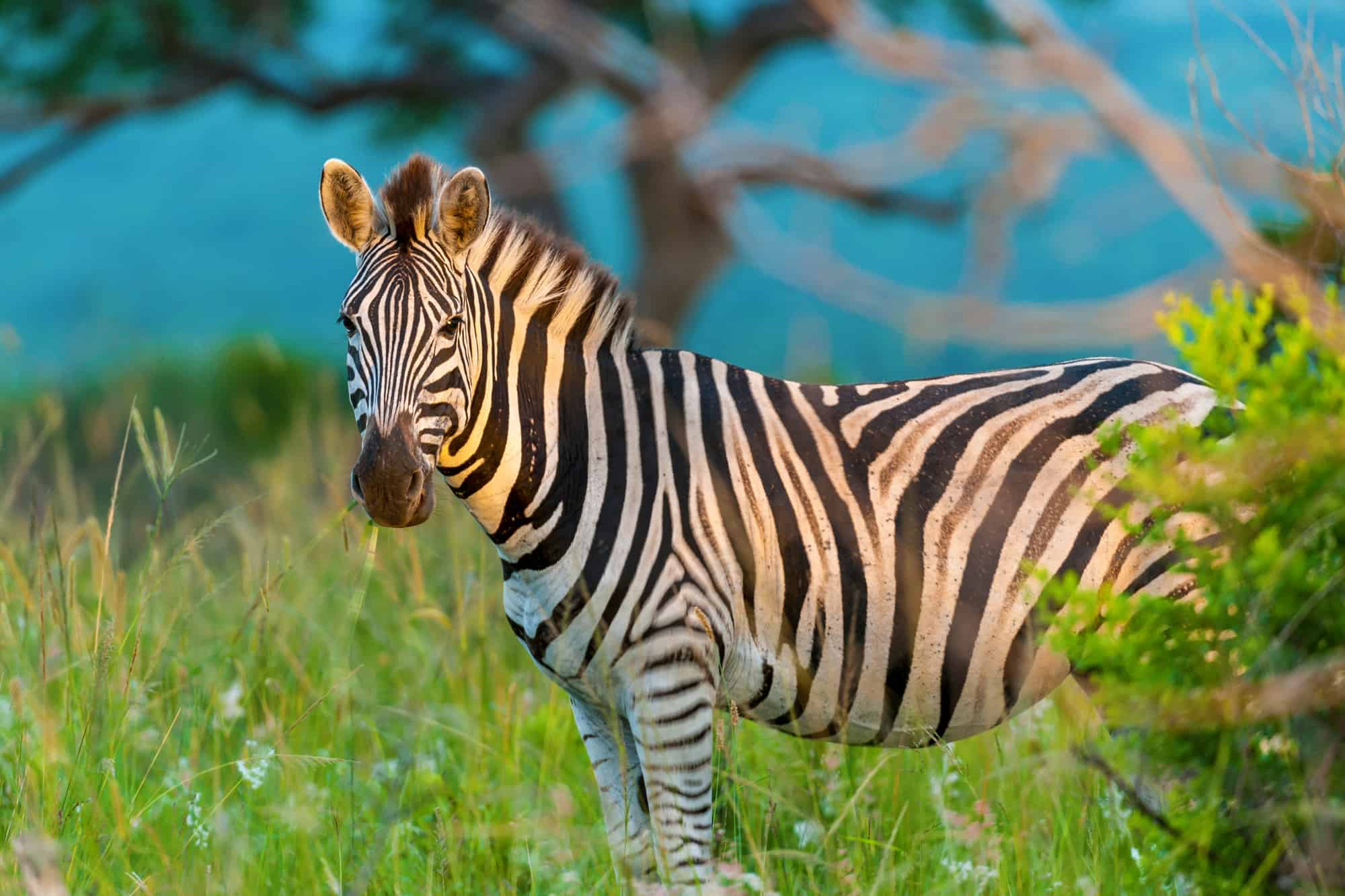
Zebras are one of the most well-known black and white animals.
©Roger de la Harpe/Shutterstock.com
As members of Equidae, zebras are popular black and white animals living in savanna woodlands and treeless grasslands. Thanks to their color pattern, they’re on the list of the most visually appealing creatures in the wild, so, unsurprisingly, a group of them is referred to as a “dazzle.”
A zebra’s stripes facilitate thermoregulation, allowing it to graze for hours in the scorching sun. So, while the black lines absorb heat to warm up the animals in cold temperatures, the white ones reflect light to cool them down when it’s hot.
Zebras are closely related to horses and donkeys because they belong to the same family. But despite that, they’re not the same. Their backs are less evolved than those of equines, so you can’t ride or use them to transport cargo.
The three species of zebras are:
- The Mountain zebra: Weighs up to 800 pounds and is the smallest species of zebra
- The Grévy’s zebra: Can weigh up to 1,000 pounds and is the largest among the three species
- The Plains zebra: Weights up to 850 pounds
2. Colobus Monkey
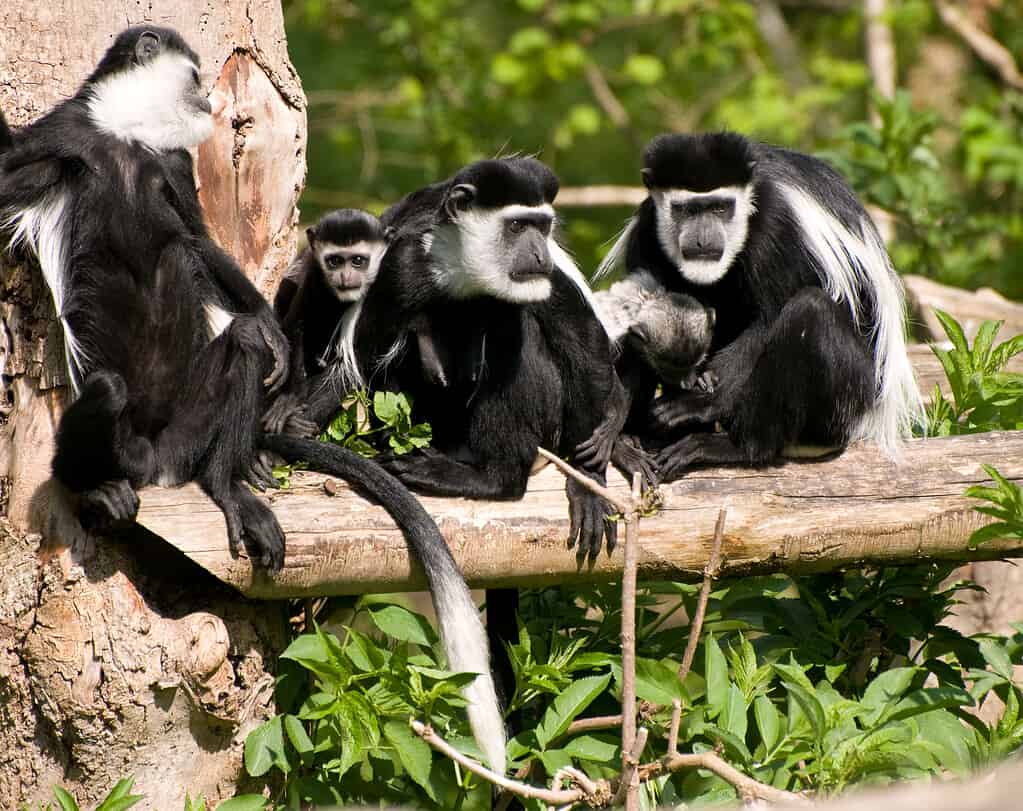
Colubus monkeys are some of nature’s most interesting black and white animals.
©Andy Poole/Shutterstock.com
Most monkeys are cheerful. They delight in grabbing things from humans and jump at every opportunity to have a good time. But interestingly, the colobus monkey is the reverse as it comes with a laid-back attitude. The black and white animal can spend a day chilling or sunning in trees, making it the most arboreal African monkey.
The colobus rarely comes down, but when it does, it’s to enjoy the most unexpected snack—clay-rich soil. The latter helps it digest the toxins in the foliage it eats. Besides the leaves, the monkey has an appetite for flowers, seeds, bark, and unripe fruits.
Although colobus monkeys are black and white, their babies are born entirely white. Encouraging alloparenting makes them easier to spot and nurture, which requires a troop to help raise the infants.
3. Giant Panda
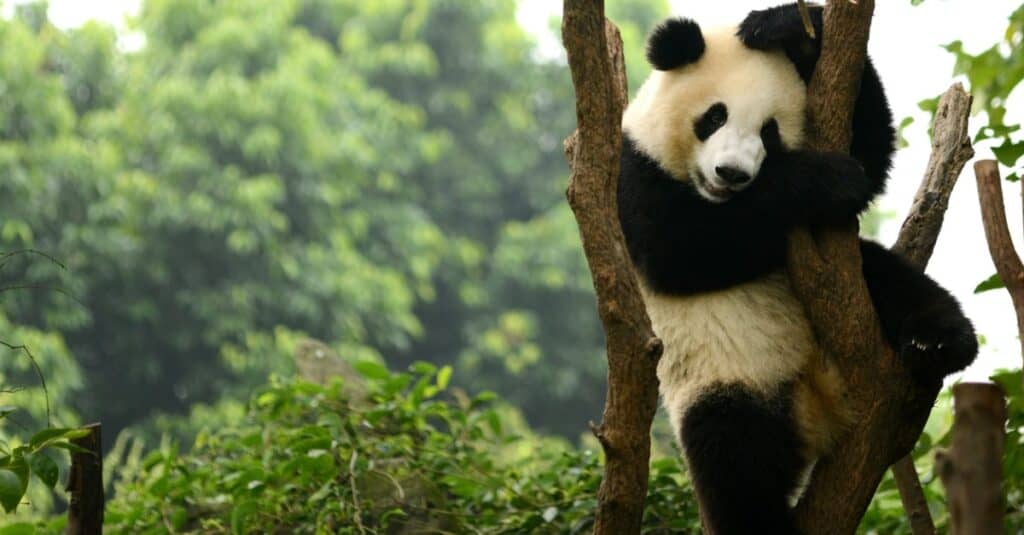
The black and white coat of the panda allows them to hide easily in the snow.
©iStock.com/dangdumrong
Pandas come with distinctive black and white coats that enable them to hide in the snow. The markings on their heads facilitate communication; the dark ears convey ferocity to scare away predators, and the eye patches allow them to identify each other. Like other family members, Ursidae, these herbivores are well-built, with solid legs and jaws and paws with sharp claws. Did you also know that they have enormous molars in mammals?
But unfortunately, giant pandas have small eyes and poor vision because they mainly live in dense forests and deep valleys. In addition, these animals are at risk, though not endangered. This is due to habitat loss since the increasing infrastructure development has limited their access to bamboo forests. Besides, panda bears lack adequate potential mates, preventing them from reproducing as much as other animals.
4. California Kingsnake
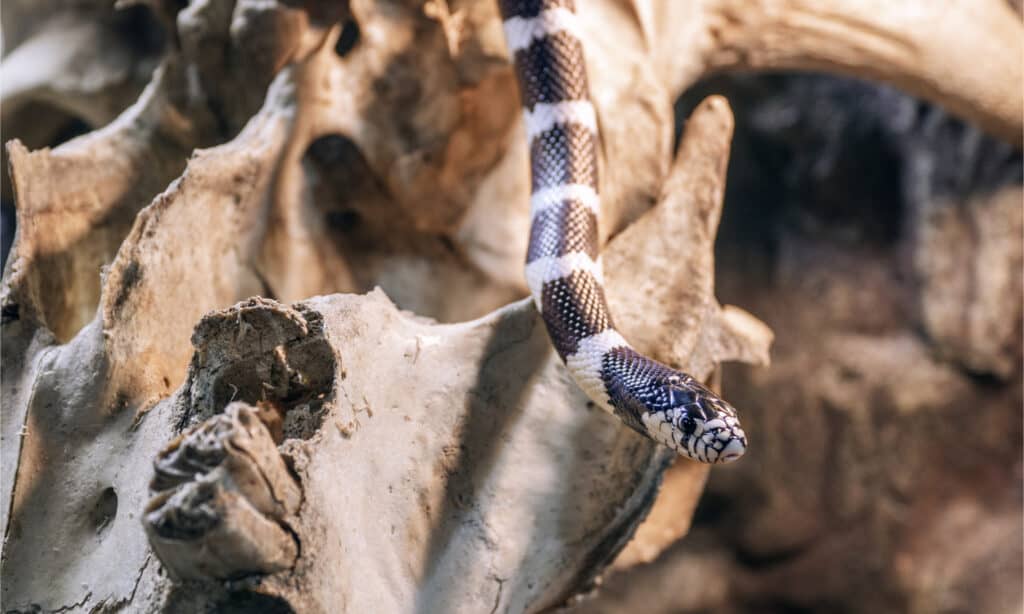
California kingsnakes are nonvenomous.
©Ann May Snz/Shutterstock.com
Most people are naturally scared of snakes. However, if you’re among them, you shouldn’t tremble whenever you see a California kingsnake. It’s one of the best options for passionate reptile keepers because it’s nonvenomous and easy to care for. So, should it bite you, serious complications should be the least of your worries.
California king snakes are aggressive feeders that constrict their prey to death. Their menu mainly consists of frogs, lizards, rats, and mice, but they also kill other snakes, including venomous ones like rattlesnakes. Thankfully, their bodies produce enzymes that break down the venom to protect them.
5. Giant Leopard Moth
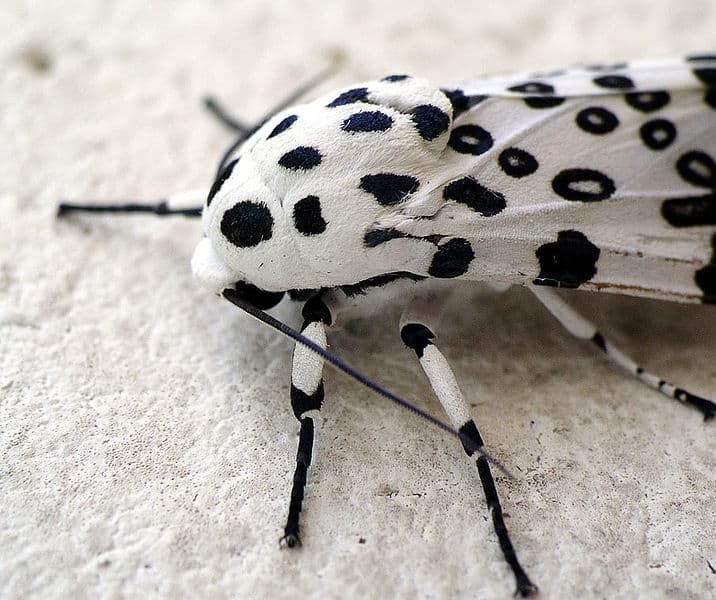
The giant
leopard
moth’s name originates from its black and white leopard spots.
©PiccoloNamek / CC BY-SA 3.0 – License
The giant leopard moth is arguably the most beautiful member of the family, Erebidae. It boasts large white wings with many solid black and hollow spots that look iridescent blue in the light. Since the adults are nocturnal, you’re only likely to see them at night, most probably in your house since they’re drawn to electric lights. That’s also when the beautiful creatures mate; their mating sessions can last more than 24 hours.
As caterpillars, giant leopard moths have a wooly exterior comprising black spines or an extremely thick layer of setae. However, this doesn’t make them dangerous—kids can even keep them as pets.
Here are more fascinating facts about giant leopard moths:
- They are solitary creatures
- The larvae can take up to 3 years to morph into adults
- Caterpillars roll themselves into balls to confuse predators
- Their black and white markings help to keep some predators at bay
6. Skunk
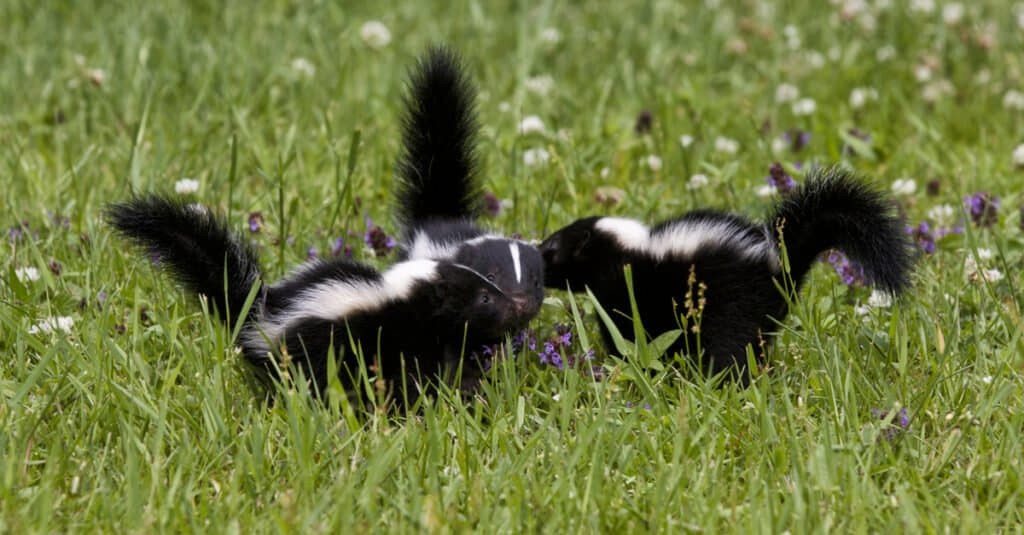
Skunks’ diets include fruit, mice, and birds.
©Debbie Steinhausser/Shutterstock.com
Have you ever smelled a strong, pungent scent reminiscent of rotten eggs? Well, that could be skunk spray hitting your nose even if you’re 12 feet away from the eye-catching black and white animal. Furthermore, it lingers for weeks and causes undesirable symptoms such as:
- Respiratory problems due to irritated lungs
- Temporary blindness and short-term burning of the eyes
- Nausea and vomiting
- Diarrhea
Skunks live in abandoned buildings, rock crevices, hollow trees, drain pipes, and burrows dug by other animals. Like giant leopard moths, they are nocturnal and spend most of their nights hunting for food. Their favorites include fruits, small rodents like mice, birds, and their eggs.
7. Dalmatian Dog

Dalmatians originated as hunting dogs, but now they’re also popular family dogs.
©iStock.com/Irina Nedikova
Known for their enthusiasm and loyalty, Dalmatians are great family dogs. They enjoy human companionship and are susceptible to depression if left alone for too long. If you live with this striking dog in your apartment, invest time in daily walks and runs with the animal, as it requires exercise to expend its limitless energy.
Moreover, Dalmatians are fantastic watchdogs, owing to their intelligence and capability to be trained. Sadly, this dog breed is susceptible to deafness; 8% of dalmatian dogs are born deaf. Screening the animals before breeding is advisable as the condition is hereditary.
8. Holstein Cow
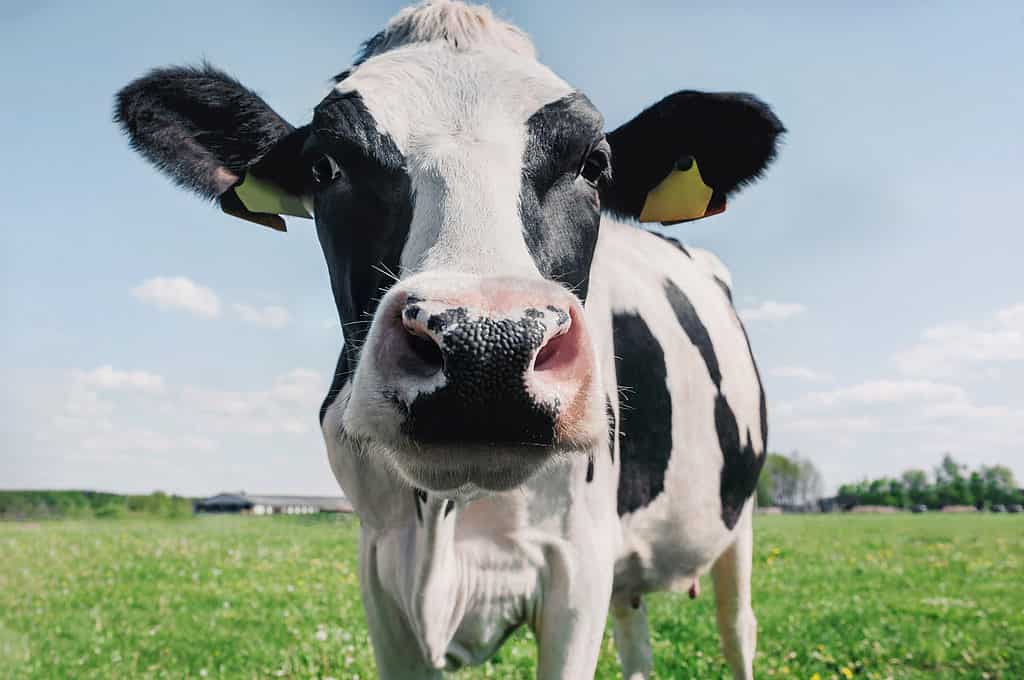
Holstein cows are gentle and even-tempered.
©Alena Demidyuk/Shutterstock.com
Holsteins are one of the most recognizable dairy cattle, thanks to their unique color pattern of black and white. Unlike jerseys, they produce less butterfat but more milk, explaining why they have larger udders than other cow breeds.
Most farmers also prefer Holsteins because they’re even-tempered, so handling them is a breeze. Other noteworthy facts about these black and white cows are:
- People believe they originated in the Netherlands about 2,000 years ago
- Winthrop Chenery, a Massachusetts breeder, initially moved them to the United States in 1852
- Most Holstein calves weigh 80-100 pounds
- A mature Holstein cow weighs roughly 1,500 pounds
- They produce quality beef
9. Royal Palm Turkey
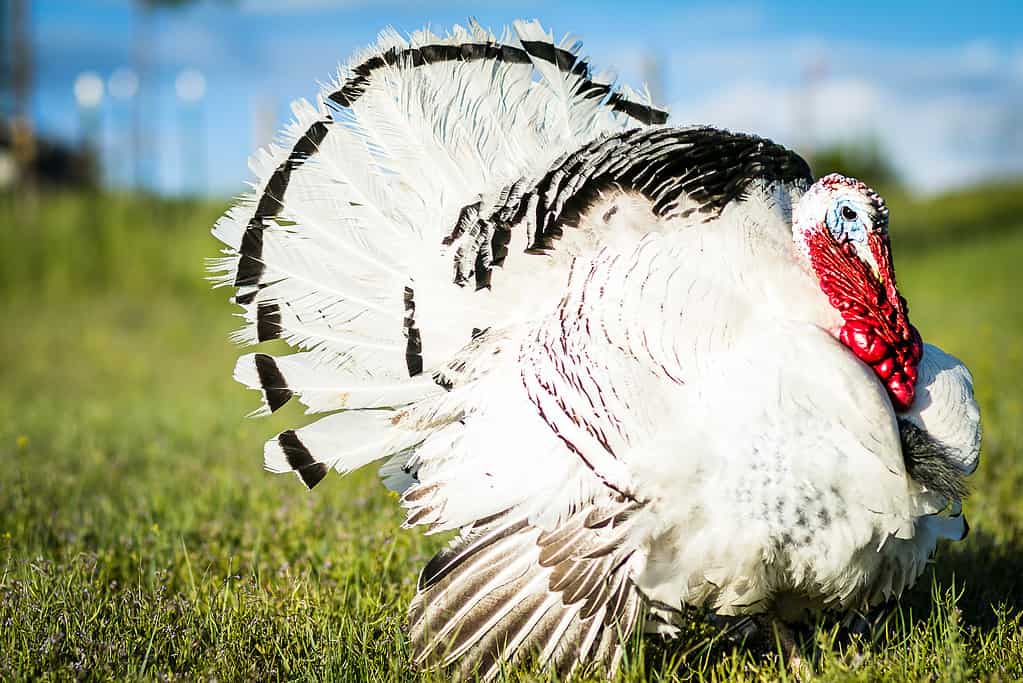
Royal palm turkeys can grow to up to 22 lbs for males and 16 lbs for females.
©JKemperPhotographyLLC/Shutterstock.com
Despite their small size, some farmers keep royal palm turkeys for meat. But others rear them primarily for exhibition purposes, owing to their striking beauty. These birds are white, with a distinct metallic edging on their feathers. While their wattles, throats, and heads are bluish-white to red, their eyes are light brown.
Because royal palm turkeys are free-range birds, nurturing them is a piece of cake. They don’t need much space for shelter, and they mainly feed themselves since they possess exceptional foraging skills. Moreover, these stunning birds eat pests to ensure your garden thrives, making them worth keeping.
6 Black And White Sea Creatures
1. Orca
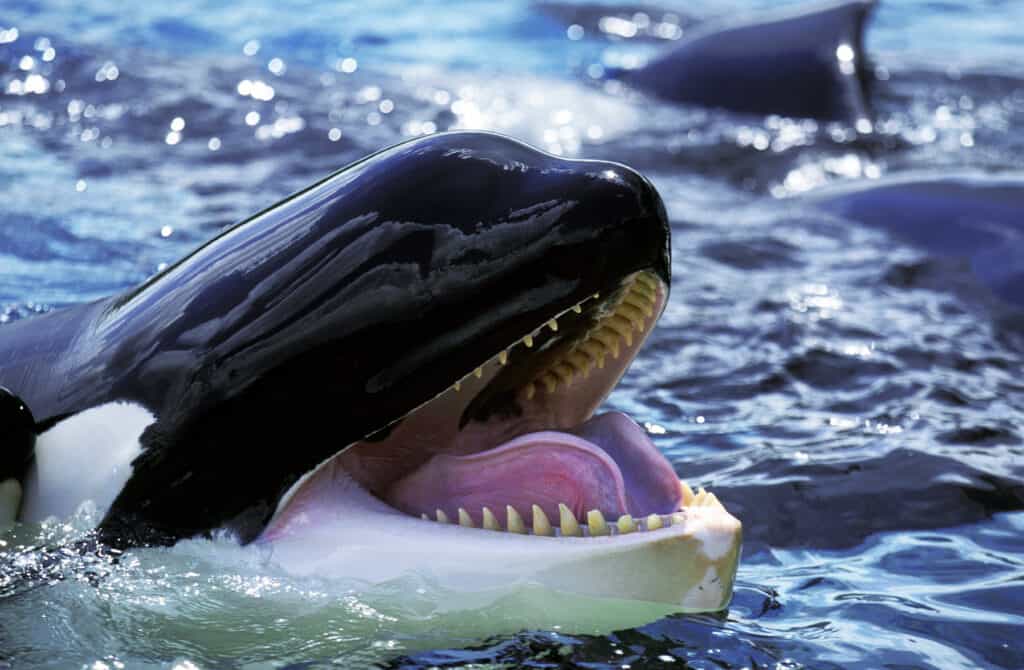
Orcas, or killer whales, don’t attack unless provoked.
©slowmotiongli/Shutterstock.com
Also known as killer whales, orcas are the largest members of the Delphinidae family. They’re notorious for hunting down other marine animals, such as penguins, sea lions, sharks, minke whales, stingrays, and seals, earning the title ‘the apex predators.’ But intriguingly, these dolphins won’t attack you unless you provoke them.
Orcas can effortlessly reach 56 km/h (34.8 mph) speeds, making them the second fastest marine animals, right below the common dolphin. Combined with their intelligence and impressive capability to master complex tasks, they make terrific entertainers at aquatic shows by performing acrobatics.
2. Dall’s Porpoise

Famous for being the most prominent porpoise family member and a solo representative of the genus Phocoenoides, the Dall’s porpoise is a fast swimmer capable of reaching speeds of 54.7 km/h (34 mph). So swift is it that it resembles a black-and-white blur when moving. Mostly, these marine mammals hang out in pairs or groups of between 10 and 12.
Contrary to most porpoises, the Dall’s porpoise is far from shy. It intentionally tracks down high-speed vessels to bow-ride. Furthermore, the toothed whale enjoys hunting other sea creatures, including crabs, shrimp, squid, and schooling fish like herring.
3. Penguin
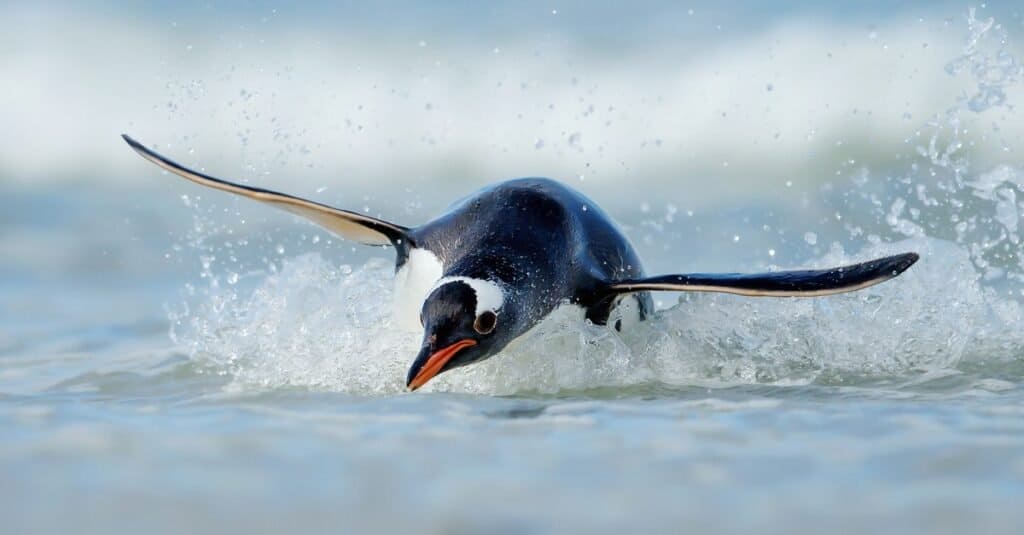
All penguins feature some form of coloring with black and white.
©Giedriius/Shutterstock.com
This aquatic, flightless bird spends most of its time in the water and only comes ashore for breeding. With a torpedo-shaped body, paddle-like flippers, solid bones, and wings, it’s an adept swimmer, diver, and hunter. But since it’s designed to live underwater, its waddle is clumsy as it takes small, quick strides.
Penguins boast binocular vision and can see underwater and in the air. Above their eyes, the supraorbital gland removes salt from their systems, allowing them to survive comfortably without fresh water. These sea creatures also have a layer of fat under their skin to keep them toasty during cold climates.
4. Razorbill
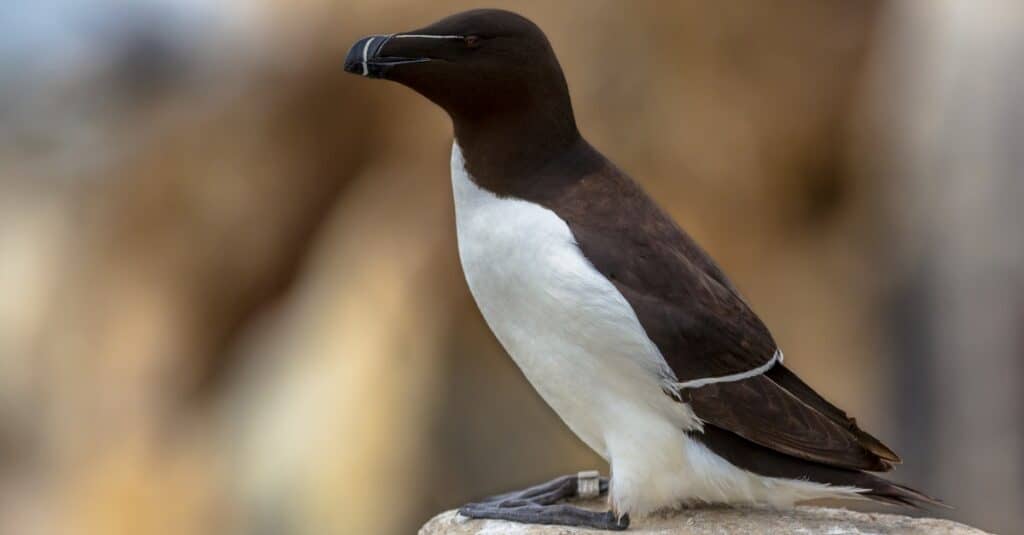
It might look like a penguin, but this black and white bird is a razorbill.
©iStock.com/CreativeNature_nl
The razorbill, or the lesser auk, is a stunning seabird from the family Alcidae. Perhaps, their most interesting aspect is they form monogamous pairs and stick to them for the rest of their lives. These sea animals can live up to 13 years on average, but one hit 41 years, setting a record for the species.
A razorbill’s diet mainly comprises:
- Small fish
- Marine worms
- Squid
- Crustaceans
- Shrimp
5. Four Stripe Damselfish

Four striped damselfish are native to the Western region of the Pacific Ocean.
©Vojce/Shutterstock.com
As its name suggests, this sea creature has four stripes, but most people often confuse it with the three-stripe damselfish, which comes with only three stripes. If you’re a beginner aquarist looking for low-maintenance fish to keep, the four-stripe damselfish is an excellent choice. But don’t let its dashing looks fool you; it’s super aggressive and will likely attack or eat other fish to seize control over the tank.
Keep Four Stripe Damselfish in a 30-gallon tank. Fill it with salt water, and ensure ample swimming space and plenty of hiding places to create a stress-free environment. Things such as rocks and plants offer good cover.
6. Black Spotted Nudibranch
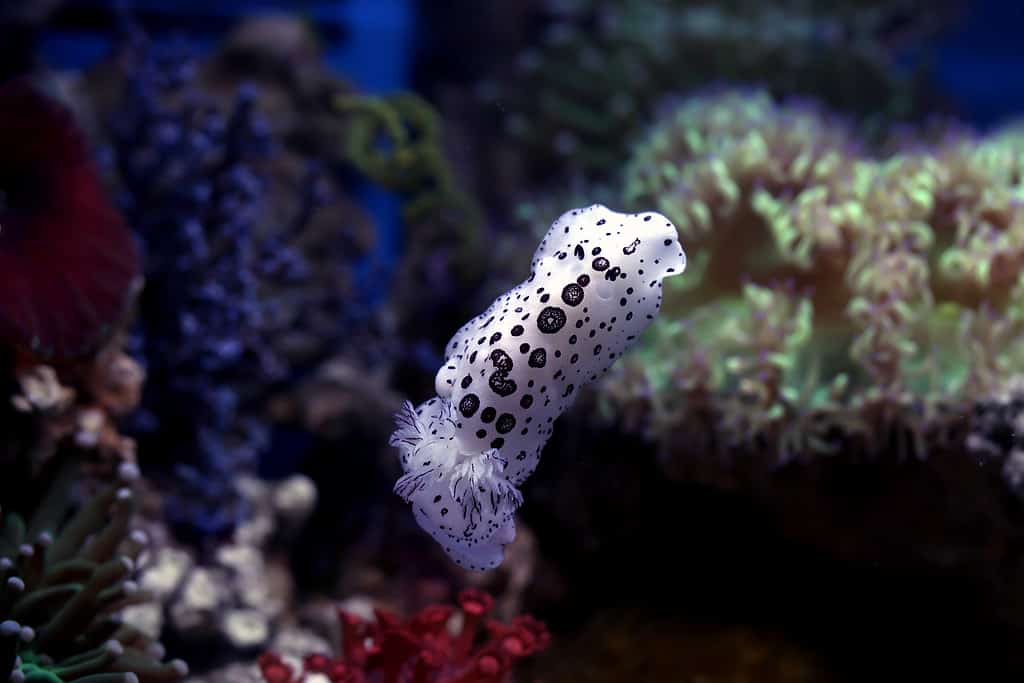
The black-spotted nudibranch is similar to a sea slug.
©Jeffry Surianto/Shutterstock.com
You’ll likely encounter the dotted nudibranch throughout the Indo-Pacific and Hawaiian water bodies. This sea slug looks adorable from a distance, but that doesn’t mean you should touch it. Your curious fingers can quickly destroy it, explaining why it’s rarely displayed in aquariums.
The black-spotted nudibranch’s head has a pair of tentacles known as rhinophores. They have scent receptors that are handy when the sea creature wants to locate nearby nudibranchs and their food. But then, the flexible organs stand out and often catch the eye of other predatory marine animals, so the slugs withdraw them as soon as they sense danger.
Other Black And White Things In Nature
Black and white animals aren’t the only black-and-white living things in nature—some flowers also have this lovely color pattern. These include:
Anemone Carmel White
The Anemone Carmel White is a white wildflower with a contrasting dark center. If you plant it, expect it to bloom in spring and mature in the summer. Mostly, it has a high bud count and strong, thick stems. And it can grow up to 40 cm tall, but only under the right conditions.
Typically, the Anemone Carmel White requires well-drained soil to thrive. Depending on the species, you can keep it outdoors, under a partially shaded place, or in the sun. The optimal temperature for growing the flower ranges from 14°C to 20°C.
Nemophila ‘Snowstorm’
This unique flower with a dazzling dotted look belongs to the family Boraginaceae. You can grow it from tiny seeds since you only need to sprinkle them on a pot’s fertile, moist soil surface. A spacing of 10cm (4″) is ideal, and make sure to water the plants regularly in hot weather.
Nemophila ‘Snowstorm’ blooms in the early days of spring. It’s easy to find them in various areas, including:
- Oregon
- The San Francisco Bay Area
- Northwestern California
White Black-Eyed Susan
This vine flower comes with pure white petals around a bold black eye. When growing it, ensure access to full sun and well-drained soil. Also, provide excellent trellis material, such as strings or netting, for the vine to climb.
Steer clear of the white black-eyed Susan if you’re prone to allergic reactions because it might trigger them. Although the flower is non-toxic and safe for most animals, humans shouldn’t eat it.
The Black And White Are All Around Nature
Check out this list of 26 black and white birds. Discover their habitats, diets, and how to identify them.
Hopefully, you now have valuable insight into some of Earth’s well-known black and white animals. Regardless of where they live, their nature, and their behavior, take the initiative to nurture them because they play a significant role in maintaining an ecological balance and sustaining life on our planet.
Remember, even the smallest creatures have an essential part to play in our world. And, of course, it doesn’t hurt to appreciate their beauty while we’re at it.
Black And White Chicken Breeds
From the light Sussex, Plymouth Rock and Brahma chicken, there are tons of black and white chicken breeds!
Also, check out this article about black and white cow breeds. There are more thank you think!
Summary Of The 15 Black And White Animals From Land To Sea
| Number | Animal |
|---|---|
| Land Animals | |
| 1 | Zebra |
| 2 | Colobus Monkey |
| 3 | Giant Panda |
| 4 | California Kingsnake |
| 5 | Giant Leopard Moth |
| 6 | Skunk |
| 7 | Dalmatian Dog |
| 8 | Holstein Cow |
| 9 | Royal Palm Turkey |
| Sea Animals | |
| 10 | Orca |
| 11 | Dall’s Porpoise |
| 12 | Penguin |
| 13 | Razorbill |
| 14 | Four Stripe Damselfish |
| 14 | Black Spotted Nudibranch |
The photo featured at the top of this post is © Andy Poole/Shutterstock.com
Thank you for reading! Have some feedback for us? Contact the AZ Animals editorial team.






